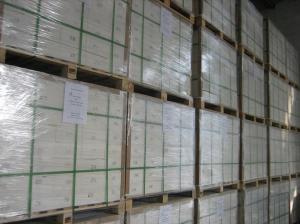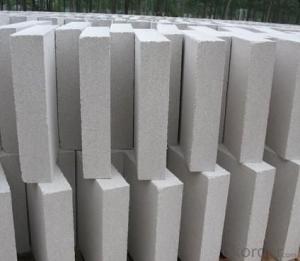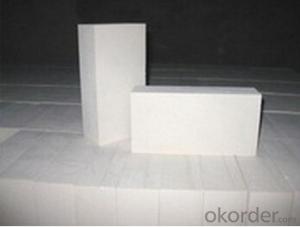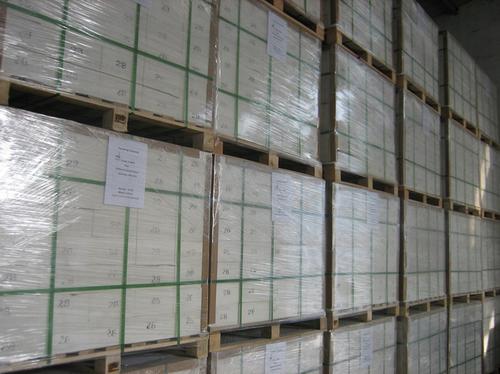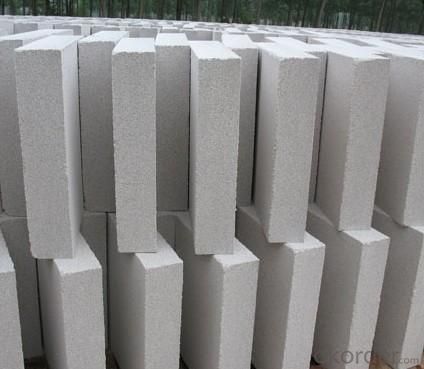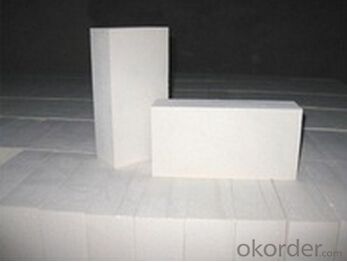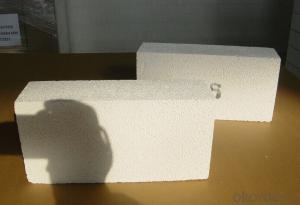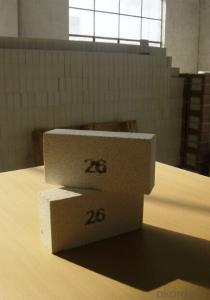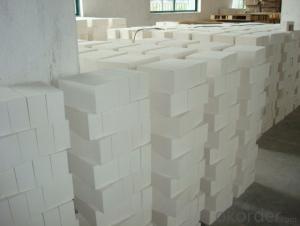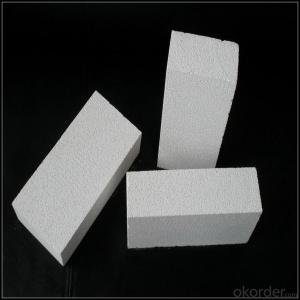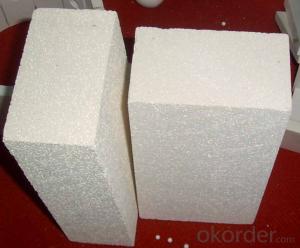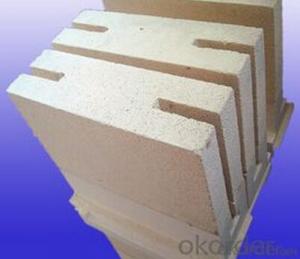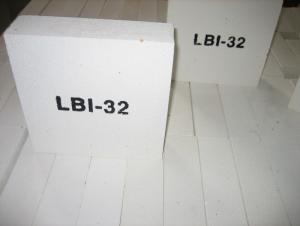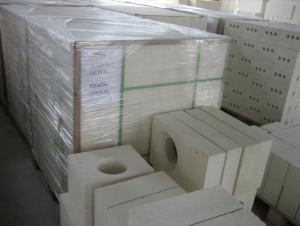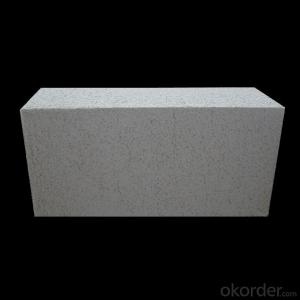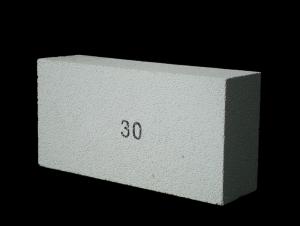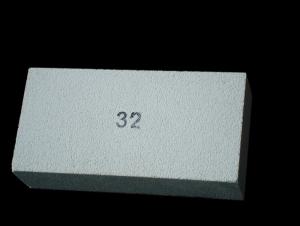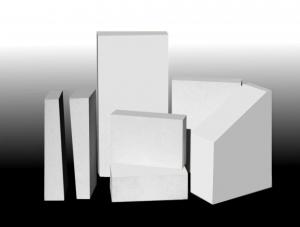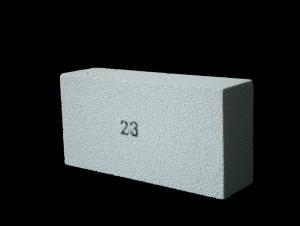Insulating Fire Brick - Refractory Mullite Insulating Fire Brick GJM28
- Loading Port:
- Shanghai
- Payment Terms:
- TT OR LC
- Min Order Qty:
- 20 m.t.
- Supply Capability:
- 100000 m.t./month
OKorder Service Pledge
OKorder Financial Service
You Might Also Like
General Information
CMAX insulating firebricks are classified under temperature between 1300℃ to 1700℃, manufactured from high purity alumina clay.
1. Lower content of iron, alkaline and impurities, good high temperature properties.
2. Homogeneous structure, light weight, energy saving because lower heat storage in the furnace during cooling cycles.
3. High strength, good thermal shock resistance under high temperature.
4. Precise sizes due to grinding and shaping after sintering, which meets the requirement of construction.
5. Max service temp: Up to 1730C (3160F)
Feature
Light weight and low thermal conductivity
Low heat storage
Low iron and impurities
High thermal shock resistance
Application
CMAX insulating firebricks can be used as a hot face lining directly exposed to the heat or as a backup insulation layer in iron and steel mills, non-ferrous foundries, petrochemical, ceramic, glass.
ITEM | GJM30 | GJM28 | GJM26 | GJM23 |
Classification Temperature, ℉/℃ | 3000/1650 | 2800/1540 | 2600/1430 | 2300/1260 |
Bulk Density,g/cm³ | ≤1.0 | ≤0.9 | ≤0.8 | ≥0.5 |
Reheating Linear Change, % | ≤0.9 (1550℃,12 h) | ≤0.8 (1510℃,12 h) | ≤0.7 (1410℃,12 h) | ≤0.5 (1230℃,12 h) |
Al2O3 Content, % | ≥75 | ≥65 | ≥55 | ≥45 |
Fe2O3 Content, % | ≤0.5 | ≤0.6 | ≤0.7 | ≤1.0 |
Thermal Conductivity: | ||||
800℃, w/m.k | ≤0.39 | ≤0.37 | ≤0.35 | ≤0.18 |
1000℃, w/m.k | ≤0.43 | ≤0.41 | ≤0.39 | ≤0.20 |
1200℃, w/m.k | ≤0.48 | ≤0.46 | ≤0.43 | --- |
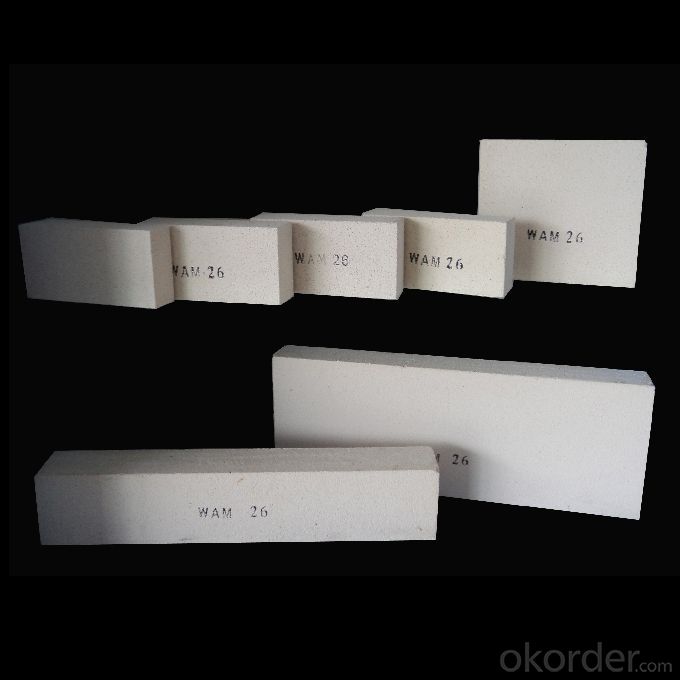
- Q: Can insulating fire bricks be used in the construction of smelting ovens?
- Yes, insulating fire bricks can be used in the construction of smelting ovens. They have excellent thermal insulation properties, high temperature resistance, and can withstand the intense heat generated during the smelting process. This makes them an ideal choice for lining the walls and floors of smelting ovens to maintain high temperatures and minimize heat loss.
- Q: Are insulating fire bricks resistant to fluorine gas?
- Yes, insulating fire bricks are generally resistant to fluorine gas due to their refractory properties and ability to withstand high temperatures and chemical corrosion.
- Q: How do insulating fire bricks affect the overall insulation efficiency of a process?
- Insulating fire bricks significantly enhance the insulation efficiency of a process by providing a high level of thermal resistance. These bricks have low thermal conductivity and can withstand high temperatures, effectively minimizing heat transfer and reducing energy loss. This improved insulation helps maintain consistent and controlled temperatures, leading to increased energy efficiency and reduced fuel consumption in various industrial processes.
- Q: How do insulating fire bricks help to conserve energy?
- Insulating fire bricks contribute to energy conservation in several ways. Firstly, these bricks are crafted from materials with high thermal resistance, enabling them to effectively impede heat transfer. When utilized in the construction of furnaces, kilns, or other heat-generating equipment, they create a protective barrier that prevents heat loss to the surroundings. Consequently, this diminishes the amount of energy required to maintain a consistent temperature within the equipment. Furthermore, insulating fire bricks possess low thermal conductivity, meaning they do not readily conduct heat. Consequently, they impede the transfer of heat from the hot side to the cold side, resulting in minimal heat loss and ensuring that more energy is utilized for its intended purpose, rather than being squandered. Moreover, insulating fire bricks possess a high heat capacity, allowing them to efficiently absorb and retain heat. This characteristic proves advantageous as it aids in stabilizing temperature fluctuations by gradually releasing stored heat over time. Consequently, this reduces the necessity for constant energy input to maintain the desired temperature. To summarize, insulating fire bricks aid in energy conservation by reducing heat loss, minimizing heat transfer, and stabilizing temperature fluctuations. By incorporating these bricks into various heat-generating applications, energy consumption can be significantly decreased, leading to cost savings and a more sustainable utilization of resources.
- Q: Can insulating fire bricks be used in foundries?
- Yes, insulating fire bricks can be used in foundries. They are commonly used as lining materials for various high-temperature applications, including foundries. Insulating fire bricks provide excellent thermal insulation, reducing heat loss and improving energy efficiency in the foundry process. Additionally, they have good resistance to thermal shock and can withstand the extreme temperatures and harsh conditions often found in foundry environments.
- Q: Can insulating fire bricks be used in industrial furnaces?
- Industrial furnaces can indeed utilize insulating fire bricks. These bricks are engineered to endure high temperatures and possess exceptional insulation properties. They are fabricated from lightweight refractory materials like alumina, silica, or mullite, all of which have low thermal conductivity. This enables them to effectively retain heat within the furnace, thereby decreasing heat loss and enhancing energy efficiency. In the context of industrial furnaces, where elevated temperatures are necessary for various processes such as metal melting, glass production, or ceramic manufacturing, insulating fire bricks can be employed to line the furnace's internal walls and floor. Their insulation capabilities aid in maintaining a consistent temperature inside the furnace, guaranteeing optimal conditions for the industrial procedure. Another advantage of insulating fire bricks is their lightweight nature, which simplifies handling and installation when compared to conventional dense fire bricks. This streamlined process can save time and reduce labor expenses during the construction or repair of industrial furnaces. However, it is important to note that the specific type and composition of insulating fire bricks should be chosen with care, taking into account the operating temperature and requirements of the industrial furnace. Different types of insulating fire bricks possess varying temperature limits and resistance to thermal shock. Therefore, it is advisable to consult with a professional or refractory expert to ensure the appropriate selection and installation of insulating fire bricks in industrial furnaces.
- Q: What is the refractoriness of insulating fire bricks?
- The refractoriness of insulating fire bricks refers to their ability to withstand high temperatures without losing their structural integrity or undergoing significant thermal expansion. Insulating fire bricks are specifically designed to have a high resistance to heat, making them suitable for applications that involve exposure to extreme temperatures, such as in furnaces, kilns, and fireplaces. The refractoriness of insulating fire bricks is typically measured using the refractoriness under load (RUL) test. This test involves subjecting a sample brick to a predetermined temperature while placing a specified load on it. The RUL is determined by measuring the temperature at which the sample brick exhibits a specified deformation or failure. Insulating fire bricks usually have a high refractoriness, allowing them to withstand temperatures ranging from 1,200 to 1,400 degrees Celsius (2,192 to 2,552 degrees Fahrenheit). This high refractoriness is achieved through the use of special materials and manufacturing techniques that result in a dense and uniform structure with low thermal conductivity. The low thermal conductivity of these bricks helps to minimize heat transfer, making them effective insulators. In addition to their high refractoriness, insulating fire bricks also possess other desirable properties, such as excellent thermal shock resistance, low thermal expansion, and good mechanical strength. These qualities make them ideal for use in applications where maintaining a consistent temperature and preventing heat loss are crucial. Overall, the refractoriness of insulating fire bricks plays a vital role in determining their suitability for high-temperature applications, as it ensures that they can withstand the extreme heat without compromising their structural integrity or insulating properties.
- Q: Do insulating fire bricks have a low thermal expansion rate?
- Yes, insulating fire bricks typically have a low thermal expansion rate.
- Q: Can insulating fire bricks be cut to size?
- Indeed, it is possible to alter the dimensions of insulating fire bricks. Usually composed of lightweight refractory substances like expanded clay or vermiculite, insulating fire bricks are quite manageable to cut. Saws or knives are sufficient tools for this task. It is crucial to bear in mind that precautions should be taken while cutting insulating fire bricks to ensure safety. Wearing protective goggles and a dust mask is recommended due to the potential dust and small particles generated during the cutting process. Furthermore, it is advisable to either refer to the manufacturer's instructions or seek professional guidance to guarantee the correct technique and tools are employed for cutting insulating fire bricks.
- Q: What bricks are thermal insulation bricks?
- Insulating bricks, a new type of product that can replace tiles, are mainly used in toilets, kitchens, TV sets, bedrooms, walls and so on. And brightly colored, various specifications, can be cut at random, the section neatly.
Send your message to us
Insulating Fire Brick - Refractory Mullite Insulating Fire Brick GJM28
- Loading Port:
- Shanghai
- Payment Terms:
- TT OR LC
- Min Order Qty:
- 20 m.t.
- Supply Capability:
- 100000 m.t./month
OKorder Service Pledge
OKorder Financial Service
Similar products
Hot products
Hot Searches
Related keywords
